168 – Drawbored Mortise & Tenon
Video - March 27, 2012
The mortise and tenon is one of the strongest fundamental joints available to woodworkers, but there are a couple of ways we can make the joint even stronger and longer-lasting. One option is to simply reinforce with pegs. While this doesn’t really make the joint all that much stronger, it does help hold the parts together in the event of glue failure. I have repaired numerous chairs where the only thing preventing the piece from catastrophic joint failure was a small 1/4″ dowel driven through a key tenon. So if you don’t mind the way it looks, pegging your mortise & tenon joints is not a bad idea. But we can do even better.
The Drawbored Mortise & Tenon
 A drawbored mortise & tenon joint is similar to the pegged version, only the hole in the tenon is slightly offset so that when the peg is driven home, it pulls the tenon further into the mortise. Most of the time, a joint with this much mechanical strength really doesn’t even require glue! But being the “belt and suspenders” kind of guy that I am, I like to use glue anyway.
A drawbored mortise & tenon joint is similar to the pegged version, only the hole in the tenon is slightly offset so that when the peg is driven home, it pulls the tenon further into the mortise. Most of the time, a joint with this much mechanical strength really doesn’t even require glue! But being the “belt and suspenders” kind of guy that I am, I like to use glue anyway.
This technique can be used on anything from door frames to workbenches. I’m using the drawboring technique on all of my mortise & tenon joints on my Roubo workbench. I want this sucker to be bullet-proof!
How to Drawbore
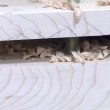 To drawbore, you need to have a finished mortise and tenon that is already cut and ready to go. Drill two holes through the mortise piece, making sure you go deep enough to penetrate the material on the other side of the mortise.
To drawbore, you need to have a finished mortise and tenon that is already cut and ready to go. Drill two holes through the mortise piece, making sure you go deep enough to penetrate the material on the other side of the mortise.
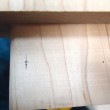 Dry assemble the joint and use a brad point bit to locate and transfer the hole centers in the tenon. Disassemble the joint and for better visibility, use a pencil to darken the marks in the cheek of the tenon.
Dry assemble the joint and use a brad point bit to locate and transfer the hole centers in the tenon. Disassemble the joint and for better visibility, use a pencil to darken the marks in the cheek of the tenon.
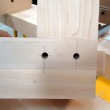 Measure and mark the offset (the offset should be located closer to the shoulder of the tenon). How much offset depends on the wood and the application. A softer wood and a more demanding application might require a 1/8″ offset. A small door frame made from a dense exotic hardwood might require only 1/32″. But I would say on average, 1/16″ offset is probably a safe bet. Drill holes in the tenon at the new offset marks.
Measure and mark the offset (the offset should be located closer to the shoulder of the tenon). How much offset depends on the wood and the application. A softer wood and a more demanding application might require a 1/8″ offset. A small door frame made from a dense exotic hardwood might require only 1/32″. But I would say on average, 1/16″ offset is probably a safe bet. Drill holes in the tenon at the new offset marks.
Homemade Dowel Pins
You can use commercial dowel stock for the pins but I find it much more fun to use a dowel plate to create my own. The advantage here is that you can use any species you have in your shop! Once the pins are cut to length, use a chisel or utility knife to sharpen one end to a blunt point. If you don’t do this, the pin will never be able to maneuver around the offset and you could very well break the pin or the tenon.
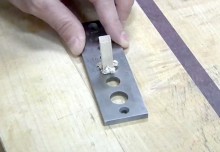
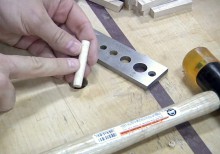
Hammer it Home!
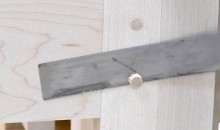 Hammering the pins in place does take a little more effort than you are probably used to but keep at it. When the pin contacts the offset hole you will actually notice it starts tilting slightly. Once you reach the stock on the other side of the tenon, the pin straightens out again and bottoms out. Simply let the glue dry (if you used glue), and then use a flush trim saw to trim the excess pin stock.
Hammering the pins in place does take a little more effort than you are probably used to but keep at it. When the pin contacts the offset hole you will actually notice it starts tilting slightly. Once you reach the stock on the other side of the tenon, the pin straightens out again and bottoms out. Simply let the glue dry (if you used glue), and then use a flush trim saw to trim the excess pin stock.
I recommend practicing this technique a few times before trying it on an important project. Once you get the hang of it, you’ll be drawboring mortise & tenon joints till the cows come home. I don’t own any cows so I’m guessing that’s going to be a really long time for me.



